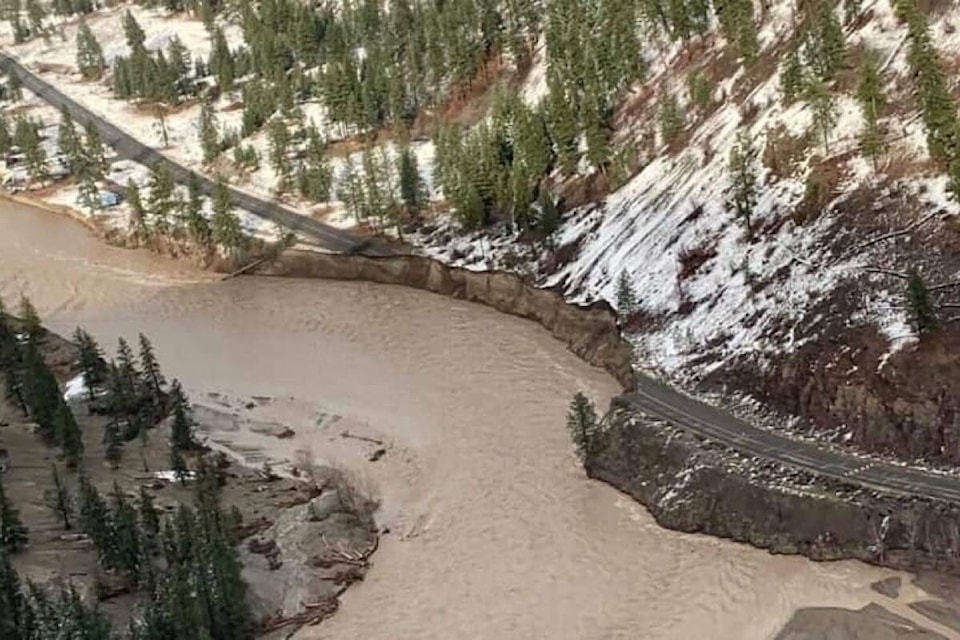The Province is working on ways to allow residents along Highway 8 between Spences Bridge and Merritt to access their properties, Transportation Minister Rob Fleming said at a press conference on Dec. 3.
He appeared to confuse the Fraser Canyon with the Nicola Valley when he said that the Province is working with Cook’s Ferry Band and Shackan First Nation in the Fraser Canyon before making it clear he was speaking of the Highway 8 region, where he said they were working on saving properties, adding that they had managed to save a house that was in danger by putting in rip rap to protect it from floodwater.
“There is a lot happening,” he said, noting that roads were being punched in to give access to some properties. “Some of them are forest service roads that are being upgraded and widened and cleared on a temporary basis.” He added that more information about temporary access, as well as the permanent rebuilding plans, will be shared in the days ahead.
TNRD Area “I” director Steve Rice, who is one of the affected residents of Highway 8, says that he has been assured by the Province that they plan to rebuild the highway, which was damaged in 18 different sections. However, he says that the extent of the damage means that shovels won’t be in the ground for a while.
Last week, some residents were able to access their properties by helicopter thanks to the Canadian Armed Forces, which arranged flights so that people could take steps to winterize properties and retrieve some items. Private companies have also been arranging flights for residents, and have airlifted several animals to safety.
Fleming said that TELUS and BC Hydro were working to restore phone and internet service and power to the area between Merritt and Spences Bridge. Hydro reports that 87 power poles and 14 transformers along Highway 8 were destroyed in the flooding, but last week they were able to restore power to 40 customers along Highway 8 between Nooaitch and Dot Ranch.
Aircraft are being used to get supplies in to places that no longer have road access, and the Province is working with the Thompson-Nicola Regional District and area First Nations on plans for restoring road access and rebuilding the infrastructure that was lost.
Highway 3 (the Hope-Princeton) remains the only route to the B.C. Interior available to commercial truck drivers, and Fleming noted that both Highway 12 (Lytton to Lillooet) and Highway 99 south of Lillooet have had to close temporarily due to rockslides. There have also been several accidents along Highway 3, and Fleming said that the Province and the trucking industry were working to get the message to drivers about safety and driving to conditions.
“We are still seeing too many accidents and we need that situation to improve,” Fleming said on Dec. 6. Detailed maps for drivers who might be unfamiliar with the road, new highway signage warning of steep and winding sections, enhanced winter road maintenance, and an increased police presence are some of the measures now in place to improve safety on the route.
Fleming said there is “intensive” work being done on Highway 1 through the Fraser Canyon and Highway 5 (Coquihalla) to protect the infrastructure that remains usable, as well as prepare for upcoming work and get the necessary contractors. “We’re in the planning stage of what that will look like in terms of temporary access,” he said, adding that the Province is committed to “build back better” in a way that takes into account the effects of climate change.
Seven sites were impacted along Highway 1 through the Fraser Canyon, and a temporary highway detour is being constructed at Tank Hill.
A temporary structure will replace the damaged Nicomen Bridge, which needs to be repaired, and work continues at Jackass Mountain, where a large section of highway was washed away by a landslide.
The cost of rebuilding the impacted highways will be substantial. Requests for Qualifications (RFQs) that have gone out in relation to various highway rebuilding projects are in the $20 to $50 million range each, with some exceeding $50 million. “It will be very significantly expensive to rebuild our infrastructure, and to build it to a higher, more resilient standard,” Fleming said. He added that 130km of the Coquihalla and 20 locations along the corridor sustained damage, and a temporary re-use plan is in the works to get the highway open.
There is no firm reopening date for either the Coquihalla or the canyon route. It is estimated that Highway 1 through the canyon should be open with temporary fixes in place by mid-January 2022, while temporary work to allow the Coquihalla to reopen to limited traffic should be complete by the end of January, weather permitting. It is anticipated that the routes will only be open for commercial, essential, and local traffic until more permanent repairs can be carried out.
editorial@accjournal.ca
Like us on Facebook and follow us on Twitter
